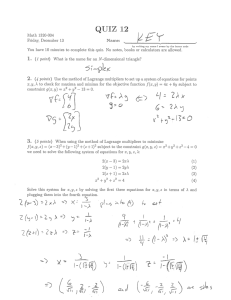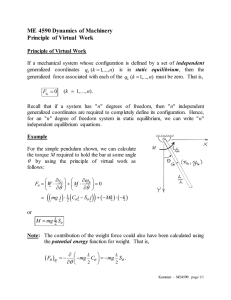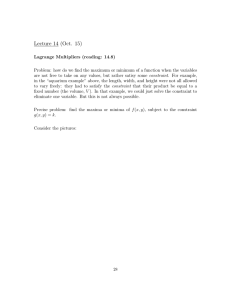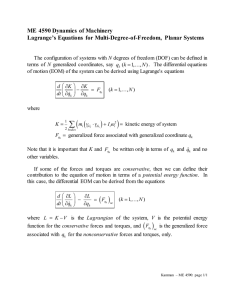advertisement
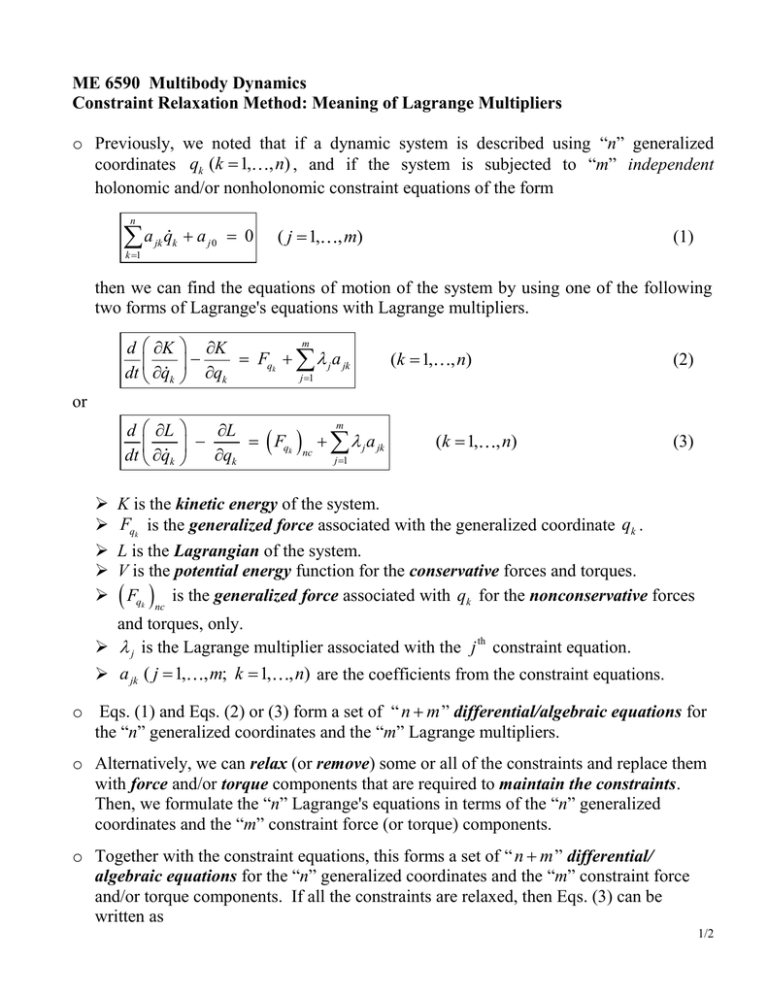
ME 6590 Multibody Dynamics Constraint Relaxation Method: Meaning of Lagrange Multipliers o Previously, we noted that if a dynamic system is described using “n” generalized coordinates qk (k 1, , n) , and if the system is subjected to “m” independent holonomic and/or nonholonomic constraint equations of the form n a k 1 q a j0 0 jk k ( j 1, (1) , m) then we can find the equations of motion of the system by using one of the following two forms of Lagrange's equations with Lagrange multipliers. d K dt qk m K F j a jk qk q j 1 k (k 1, , n) (2) or m d L L Fqk j a jk nc dt qk qk j 1 (k 1, , n) (3) K is the kinetic energy of the system. Fqk is the generalized force associated with the generalized coordinate qk . L is the Lagrangian of the system. V is the potential energy function for the conservative forces and torques. Fqk is the generalized force associated with qk for the nonconservative forces nc and torques, only. j is the Lagrange multiplier associated with the j th constraint equation. a jk ( j 1, , m; k 1, , n) are the coefficients from the constraint equations. o Eqs. (1) and Eqs. (2) or (3) form a set of “ n m ” differential/algebraic equations for the “n” generalized coordinates and the “m” Lagrange multipliers. o Alternatively, we can relax (or remove) some or all of the constraints and replace them with force and/or torque components that are required to maintain the constraints. Then, we formulate the “n” Lagrange's equations in terms of the “n” generalized coordinates and the “m” constraint force (or torque) components. o Together with the constraint equations, this forms a set of “ n m ” differential/ algebraic equations for the “n” generalized coordinates and the “m” constraint force and/or torque components. If all the constraints are relaxed, then Eqs. (3) can be written as 1/2 d L L Fqk Fqk nc constraints dt qk qk (k 1, , n) (4) Example: The Simple Pendulum o For the simple pendulum shown, we will use q1 x and q2 y as the generalized coordinates, and we will relax the length constraint of the pendulum in the formulation. Lagrange's equations can then be written in the form of Eq. (4). o Here, L 12 m x 2 y 2 mgy , F qk nc 0 , and the contributions of the constraint force to the right hand sides of the equations are Fx constraint T v Fy constraint T v y T x L i y L j xi yj x T x L i y L j xi yj x T x L (5) y T y L (6) o Substituting into Lagrange's equations (4) and supplementing with the twice differentiated constrain equation give the following equations of motion mx Lx T 0 my mg Ly T 0 (7) xx yy x 2 y 2 0 o Using Lagrange multipliers, we showed in previous notes that the equations for the pendulum could be written as mx x 0 my mg y 0 (8) xx yy x 2 y 2 0 o Comparing Eqs. (7) and (8), we see that the Lagrange multiplier T / L the tension force per unit pendulum length. 2/2
